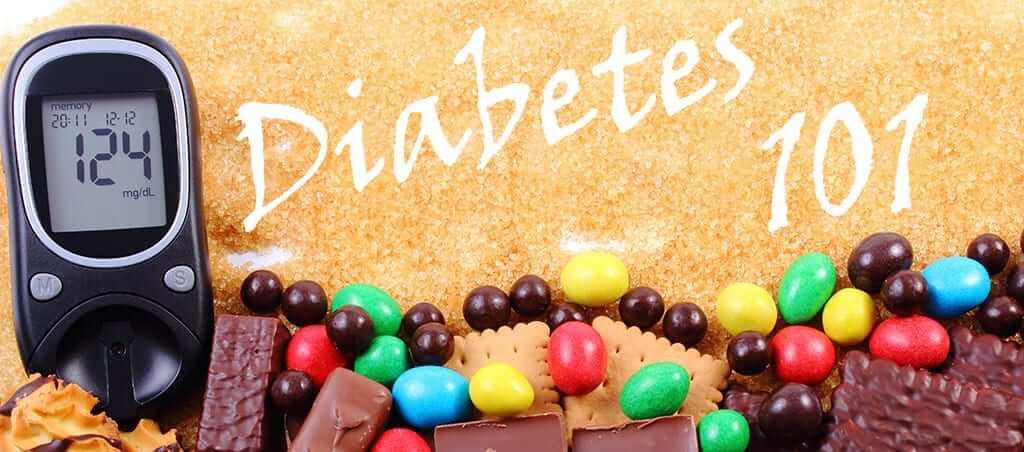As fall season approaches, it is a good time to review diabetes basics. Although some of you may already know the basics, you can never stop learning. See how well you do on the following questions. Remember that “medical costs and lost work and wages for those with diabetes totals $245 million dollars yearly.” See what you can do to lower these costs.
What is Diabetes?
Diabetes is a “chronic disease that affects how well your body turns food into energy.” After food is eaten, the carbohydrates break down into sugar or glucose. Insulin which is made in the beta cells of the pancreas acts like a key to let the glucose into the cells of the body for energy. When this system breaks down, diabetes develops.
What are the 3 Main Types of Diabetes?

Who is at Risk for Developing Type 2 Diabetes?
Certain groups of people are more at risk for type 2 diabetes. Those groups include: being over age 40, family history, being overweight or obese, having a sedentary lifestyle, being a smoker, having had gestational diabetes, being African American, Latino/Hispanic, Pacific Islander or Native American.
What About Pre-Diabetes? Is it Common?
Over 84 million people in the United States have pre-diabetes. Unfortunately, most people are unaware of the condition. Pre-diabetes can convert to type 2 diabetes and set you up for other health problems including cardiovascular disease, stroke and nerve ending disease. Getting a fasting blood glucose test is a way to check for the condition. Many times, this can be accomplished at a hospital health fair, community health event or at your doctor’s office. Any number over 99-125mg/dl is considered pre-diabetes.
How Many People Have Diabetes in the US?
According to the CDC, “there are 30.3 million people with diabetes with over 7 million undiagnosed.” This leads to a lot of complications down the road.
OK, I Have Been Diagnosed with Diabetes, Now What?

Who Else Should be on my Health Care Team?
You should see a dentist/periodontist 2-4 times a year depending on your specific mouth condition. Gum disease is more common with diabetes and it can cause huge swings in blood sugars when uncontrolled. You should visit a podiatrist at least yearly or up to every 3 months depending on the condition of your feet, nails and history of nerve damage or neuropathy. Anyone with a foot ulcer, open wound or foot infection should be seen more frequently.
Do I Need Certain Vaccinations When I Have Diabetes?
Diabetes, even when controlled, can make it more difficult to fight infections due to a compromised immune system. Catching the flu can play havoc with blood sugars so an annual flu shot is recommended by the CDC. Flu season runs from September thru March and the flu-shot takes 2-3 weeks to become completely effective so plan ahead. The flu vaccine is covered by most insurance plans including Medicare. You can receive it at your doctor’s office, pharmacies, health departments, minute clinics and at some places of work including hospitals. Contrary to non-medical reports, “the flu shot causes very few side effects and does not cause the flu.” Pneumonia is a big concern for those with diabetes. Pneumonia is a lung infection which can result in hospitalization and even death if not treated promptly. There are different variations of the pneumonia vaccine, so check with your physician to see which one you need. They are usually updated every 5-6 years. Tetanus shots should be updated every 10 years or when an incident occurs such as a puncture wound. Tetanus is bacteria found in soil, manure or dust and can enter the body thru an open wound. The “Tdap vaccine protects you from tetanus, pertussis (whooping cough) and diphtheria.” People with diabetes should also be vaccinated against hepatitis B. Hepatitis B can be transmitted by blood such as sharing needles, insulin syringes or other medical equipment. It can affect all age groups and can cause severe liver disease, cirrhosis. The shingles vaccine should be taken by those over 60 with diabetes. Shingles is a virus related to the chicken pox which can cause a complication called PHN, post herpetic neuralgia. This painful condition can last for years and the pain can feel like neuropathy.
What Else Can I do on my Own to Help Diabetes?
You should consider wearing medical ID on your wrist or neck depending on your personal situation. Always carry a list of medication names and dosages, doctor’s names, specialties and phone numbers as well as other medical conditions, allergies and surgeries. Depending on your own situation, you should check blood sugars with a glucose meter. Find out what are the best times to test and know what the results mean. This can help you make daily food and exercise choices. You can document your results in an old-fashioned log book or download a spread sheet to your computer. Some meters can send information directly to the physician via a Smartphone. There are continuous glucose monitoring, CGM, devices which track blood sugars every 3-5 minutes for those having more control difficulty. Find out which diabetes equipment will be helpful to you and your situation. Have extra testing supplies available so you do not run out. Strips are good for 4 months once opened. Testing solution is good for 3 months, once opened. Know how, when and why you are taking your diabetes medication. If you do not know, check with your doctor and pharmacist. Find out the common side effects and possible contraindications. Order your prescriptions on automatic refill to prevent missing any doses. Have at least 3 days of medication available prior to getting your next prescription. Never skip medication and store your medications away from heat and humidity by keeping them in the kitchen or bedroom. Insulin does not need to be refrigerated if not exposed to high temperatures once opened and is generally good for 30 days. Check on your specific type and delivery system. Be aware of hypoglycemia (low blood sugar) and the symptoms. Most people get weak, shaky, sweaty, hungry, headache, increased heart rate or blurry vision. People who have “hypoglycemic unawareness” may experience no symptoms at all. Always carry a glucose source, such as glucose tablets, and be prepared with healthy snacks of protein and carbohydrates such as peanut butter crackers.
What About Smoking and Diabetes?
Smoking, especially when you have diabetes is never recommended. According to the CDC, “smoking may now be a cause of type 2 diabetes. Smokers are 30-40% more likely to develop type 2 diabetes than non-smokers.” Smoking also makes diabetes harder to control once it develops. Smoking can add to the risk of heart disease, stroke, retinopathy (eye disease), neuropathy (nerve disease) and nephropathy (kidney disease). There are free stop smoking programs offered by the American Lung Association, support groups, acupuncture, hypnosis, pills and biofeedback. Find which way works best for you but quit smoking.
Does What I Eat Really Matter?

What About Physical Activity?
Although exercise alone won’t control your diabetes, it will have a huge impact on blood sugars. Physical movement will help with your weight, blood pressure, cholesterol levels and reduce your risk of diabetes complications. The basic guidelines include 30 minutes, 5 times a week but you can certainly do more. You should include aerobics, walking, swimming, biking, strength training with weights and core exercises for balance. Do what you like but be consistent. Start slowly and work your way up in time. Walking 10-20 minutes after a meal helps bring down blood sugars.
What About Sick Days?
It is very important to be prepared for sick days when you have diabetes. You blood sugars can soar from a virus, vomiting, diarrhea, flu or infection. You can easily become dehydrated which will increase blood sugars. It is important to be prepared before you get sick. Think about an emergency plan and sick day kit. If you live alone, make sure there is someone to contact as your “emergency person”. Keep a list of all health care provider phone numbers, a list of all your medications, allergies and medical conditions on the refrigerator for easy recognition. Make sure to have a thermometer, glucose tablets, sugar-free cough syrup, sugar-free sore throat drops, anti-diarrhea and anti-nausea medication, pain/fever relievers, plenty of sugar-free fluids, clear chicken, beef or vegetable broth, sugar-free jello, extra testing supplies and ketone testing strips (type 1 diabetes). If you do not feel better in 24 hours or if your blood sugars stay at 200 mg/dl, then contact your physician. Try to eliminate a big problem by taking control early on.
Can my Mental Health Effect my Diabetes?
Yes. Stress, depression and anxiety can influence your blood sugar numbers and total physical health. If you are experiencing any of these symptoms, you should consult with your health care provider. You may need to visit a psychologist, a mental health counselor, or a social worker. You can try biofeedback sessions, join a support group or start meditation classes. You may even need medications to get control. Dealing with your mental health is an important aspect for your diabetes management.
There is never a better time to take control of your diabetes. Learn the fundamentals of care and the basics to help you with your daily blood sugar numbers. Stay on top of your diabetes to prevent complications. New treatments are coming quickly so stay up to date and informed. Best of luck!
Have a question or comment? Then post below, no registration required. I would love to hear from you!
NOTE: Consult your Doctor first to make sure my recommendations fit your special health needs.







Type 4 diabetes…… total pancreatectomy, thats me… they removed my pancreas 11 years ago, along with a bunch of other innereds they felt wasnt needed anymore.
My insulin needs are way different from type 1 or 2….
I agree with your vet that you should continue feeding her what she will eat for now. You could try BalanceIt.com (that’s like balance it) and work directly with a veterinary nutritionist for a home made recipe. Or, if you are near a vet school they also likely have a nutritionist on staff. Good luck! Joi